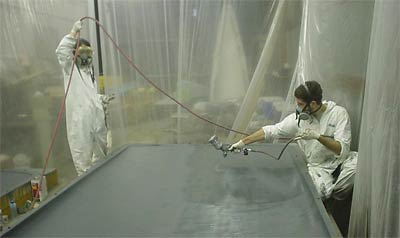"Don a bunny suit and enter the gas chamber."
It was time. After a semester of meetings, action was needed if the CalSol team was going to have a car to race. I was handed a gas mask and goggles to guard against the unfriendly chemical mold primer. Plastic drapes enclosed the boxy "gas chamber" around us as Greg, the team lead, sprayed the two molds for the body of our new car.
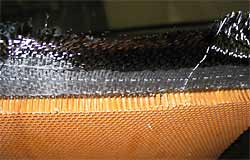 Carbon fiber covers an air-filled honeycombed sheet to make a strong, light shell. |
It turned out to be the first day of an eight-month-long construction process. The top and bottom shell molds, both behemoths, had to be prepped extensively — they had been left to nature for a year because we lacked storage space. Our body, canopy, fairings, and many other small components are all made of carbon fiber composites, which combine the strength and flexibility of carbon fiber with the stiffness of hardened epoxy (a type of adhesive). Each application has a different recipe, but the strongest combination is multiple layers of carbon fiber sandwiching a honeycombed sheet, which provides structure without adding much weight. We used this for our shells.
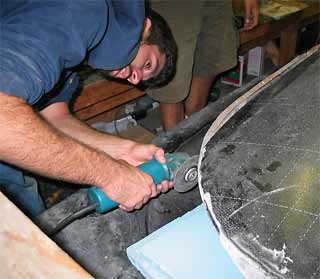 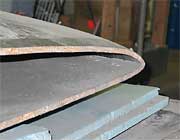 Sawing off the sides of the shell to meet new width requirements resulted in gaping holes (left) that had to be plastered over — in a high-tech way. Sawing off the sides of the shell to meet new width requirements resulted in gaping holes (left) that had to be plastered over — in a high-tech way. |
Sometimes, building and modifying the shells had its terrifying moments. For example, the maximum allowable width for a car was changed from 2 meters to 1.8 meters. We all winced at surgery time. After joining the top and bottom shells, we hacked 12cm off each side, and covered up the massive holes with panels made of the same composite materials. Today it's a slick blue intersection of curves, but back then, we were fearful the work of the past five months would fall apart before our eyes.
We already knew how easy it could be to go from success to catastrophe. Two years ago, in the American Solar Challenge from Chicago to Los Angeles, heavy rain caused many teams to fail their qualifiers. The CalSol team managed to pass the difficult timed figure eight and braking tests, but at the starting line for the race itself our motor controller malfunctioned, causing the motor to throw a magnet loose. It was a frustrating irony to have qualified, only to be denied the race experience. The University of Kentucky team was headed home, having missed out on the qualifier, but when they saw what had happened, they offered us their motor and motor controller! Camaraderie between teams is in the spirit of solar car racing, but UK went way beyond that. Our previous car, Solar Bear, still carries a University of Kentucky bumper sticker in tribute. Thanks to them, we placed second in our class!
The Next Generation: Fast-forward to the Beam Machine
Building a solar car takes at least two years. And for the first year of our current car, the Beam Machine, the electrical team had nothing to work with. The motor and motor controller were broken, and we lacked money for batteries or solar cells. Each meeting became more and more depressing; would we ever finish the car? We brainstormed crazy ideas for fund-raising – some legal, some not – threw most of them out, and grimly settled down again to searching for support through e-mails, letters and phone calls. Finally, last August, we lucked out with an obscure connection that led to finding our primary sponsor, Hybrid Technologies, Inc. Through them, we have been able to purchase solar cells and lithium ion batteries, fix our motor and motor controller, and order other necessary parts.
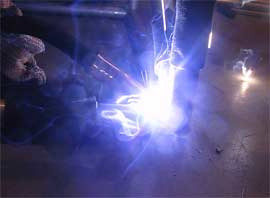 Welding the aluminum frame sparked an electrical light show. |
While we were scrounging for cash, the chassis designs were finalized. It would be our first attempt at welding aluminum, which is much trickier than welding steel. Outsourcing was too expensive, so our mechanical team lead, Jeremy, spent most of last summer practicing welding techniques before being confident enough to start constructing the chassis. And we all knew that sloppiness couldn't be tolerated. In August, we received news that the 21-year-old student driver of a solar car had been killed during the Canadian Solar Tour after veering into oncoming traffic and crashing into a minivan. Thoughts of the tragedy still remind us of the dangers of racing and the utmost importance of getting things right.
Finally, on a bright afternoon in April 2005, the Beam Machine drove for the first time on battery power. Testing was never so much fun – shouting, laughing, sprinting after the car, racing it on Beatrice (the bike), and snapping photos from a golf cart, we cheered all the way. Go CalSol!
| Going topless: Not exactly a convertible, CalSol's new car (sans the top shell) goes for its first battery-powered drive in April. (Photo by Mike Seeman) | 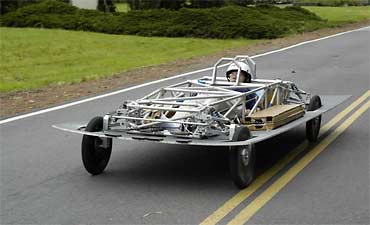 |





